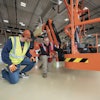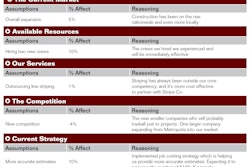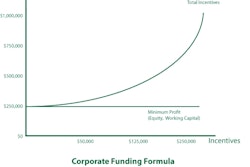This month, we are introducing a new Contractor Help Station program, which is available to readers willing to share an operating, financing, tax, burden rate, equipment rate or other problem you need help with. Send me an email ([email protected]) with your questions and Ken Hedlund and I will do our best to set you up on the path to profitability.
As I mentioned last issue, Ken Hedlund is a principal at Somerset CPAs (www.somersetcpas.com) with a dedicated team servicing the general and trade contractor industry niches. He and his team are construction/contractor specialists with many years of experience. They will work with me to figure out your problems or at least get you on the right path to addressing them.
Ken and I will make suggestions that you will then need to discuss with your professional advisors before taking action. Please note that the comments we make are the opinions of the authors. They do not necessarily reflect the views or opinions of Equipment Today, Cygnus Business Media or its editors, nor do they take any responsibility for them.
Ken and his team provided the following article this month that suggests a method to account for equipment costs, how to allocate them and how to determine if the equipment is earning a positive ROI. This is certainly a good exercise to participate in to determine if your equipment is adding to your profitability.
Today’s challenging bidding market demands unparalleled scrutiny on a company’s internal costing procedures, and more variation is seen in equipment bidding practices than in any other area of the construction market. Companies that have a keen sense of their true annual equipment pool costs seem to enjoy much more bidding success than those that take a very simplistic approach to bidding equipment, or consider equipment costs as part of their overhead structure. I have heard construction company owners state, “Depreciation is not a cash cost, so why should I figure that into my true cost equation?” That thinking is short-sighted at best, and figures to make a big difference in a company’s long-term success.
The old adage that you can manage what you measure is certainly true in the equipment arena, and that truth is evident over a long-term review of capital-intensive contractors. The fact that best-in-class contractors continually monitor both their internal and external equipment costs is no coincidence.
Equipment Cost Considerations
Equipment expenses generally fall into one of two categories: ownership and operating costs. Ownership costs consist of fixed expenses that do not vary according to the hours equipment is utilized. For example, depreciation, shop costs, property taxes, licenses and similar costs are considered ownership costs. Operating costs consist of all other costs that vary based upon hours used. Operating costs include fuel, maintenance and similar costs.
Casual (month-to-month) rentals of equipment should be 100% job costed. Equipment rented under operating leases should be included in the fleet of equipment pool costs and allocated using appropriate hourly rates as if the company owned the equipment.
When fuel prices were very unstable two years ago, some sophisticated, equipment-intensive contractors used a flexible hourly equipment rate model that incorporated a fuel cost variable that was readily changeable as fuel prices spiked or dipped. This methodology proved very helpful in estimating and tracking job costs in a fluctuating fuel price market.
Best practices dictate pooling all such costs together to collectively measure a company’s true internal costs. In this way, a company can easily project its equipment cost structure and plan for appropriate costing. The example below shows how a company might set up its equipment cost pool.
EXAMPLE:
Equipment Cost Pool
Repairs & Maintenance Expense - $549,523
Fuel - $760,956
Oil - $13,172
Depreciation, Equip. - $460,341
Subtotal: $1,783,992
Labor, Shop - $307,230
Payroll Taxes, Shop - $27,350
Fringe Benefits, Shop - $32,681
Workers Comp, Shop - $5,481
Utilities, Shop - $13,079
Parts, Shop - $69,029
Supplies, Shop - $4,276
Shop Tools & Supplies - $29,200
Depreciation, Shop - $64,870
Shop Repairs & Maintenance - $14,766
Subtotal - Shop Costs: $567,962
Insurance, Property - $30,249
Licenses/Permits 34,506
Property Tax Expense - $40,345
Subtotal, Other Equipment Costs: $105,100
Total Equipment Costs: $2,457,054
Less Equipment Costs Applied to Jobs: ($2,690,198)
Net Under (Over) Applied Equipment Costs: $(233,144)
Equipment ROI Calculation
Total Equipment at Original Cost: $4,679,155
Net over (under) applied equipment costs: $233,144
Equipment ROI: 5%
In the example, $2,690,198 was charged to direct job costs, resulting in an over-allocation of equipment costs of $233,144, or a 5% ROI. By viewing the subtotals, you can easily see that if shop and other equipment costs were omitted from the equipment pool, the estimator in essence adds almost $673,000 to overhead costs.
Hidden Equity
If your equipment depreciation is calculated by using federal tax depreciation methods and lives (double declining balance method and five-year lives), your company could benefit greatly by switching to the straight line method combined with use of the economic lives and salvage values for financial reporting purposes. This can cut annual costs of depreciation in half or even more, depending on the type and use of your fleet. For example, new dozers and excavators generally have a 10-year economic life with a 10% to 15% salvage value if used in excavation work. Cranes have an even greater salvage value percentage due to the fact that they maintain such a high percentage of their value.
The benefit of such a change can have a two-fold impact. By cutting annual costs, profits are improved. In addition, a cumulative effect on equity can be realized, whereby fixed asset values are increased with a corresponding increase in shareholders’ equity.
By using economic life and salvage values where appropriate, a company achieves a greater matching of its revenue production and related costs of producing such revenues. Because depreciation is a large percentage of the collective equipment costs, using economic lives creates a much better bidding price, which can result in more bids won when proper equipment costs are considered by all bidders.
Measuring/Recording Utilization
In order to properly measure and job cost equipment, a company should implement a logical and cost-effective way to track hours by piece of equipment. This is traditionally done either using an operating hour meter or other field reporting mechanism, such as operator hours.
Using collective annual hour totals from several recent years to project required internal hourly rates will allow the company to achieve break even or have a reasonable ROI in equipment. The calculated hourly rates are for costing purposes and are driven by many factors, including a comparison of rates to market for similar equipment. A general rule of thumb is that an internal rate might approximate 75% of the hourly rental (using monthly rental costs/standard monthly hours).
Leasing vs. Buying
Both the administrative and operations aspects of a construction company must be considered before a decision to purchase or lease is ultimately made.
On the administrative side, the structuring of an appropriately leveraged balance sheet should always be considered, especially as those that set accounting standards actively promote changes that will require operating leases to be recorded on the balance sheet. On the operations side, by tracking hours annually, a company can decide if it should own vs. lease the equipment by using inputs such as hours of use compared to the cost of renting the piece on an as-needed basis.
Also of consideration is the ready availability of equipment on the rental market. The utilization hours can be an integral basis in evaluating whether to lease or buy equipment. At the end, all of the administrative and operations pros and cons must be considered on a cost/benefits basis to reach the best decision for the company, given its unique considerations and circumstances.
Equipment Fleet Needs Analysis
One question our firm is occasionally asked is, “How do I know how much equipment I should purchase annually?” It’s a great question, but it unfortunately is not asked frequently enough. Typically, it comes when a company has taken on too much equipment debt, which probably means someone has told them they are acquiring too much iron. Here are a couple of easy rules of thumb for construction company leaders to use as a part of their equipment needs analysis.
In a mature business (at least 10 to 15 years old) that uses economic lives and methods for its depreciation and for which revenues are relatively flat, annual capital expenditures should be about equal to annual depreciation expenses. That measure should be coupled with a calculation of net book value divided by original cost for equipment equal to 45% to 50%. If a company is expecting a decline in revenues, the ratio should decline slightly, which is generally accomplished by purchasing less equipment than the company incurs in annual depreciation costs.
If a company is experiencing high growth, the ratio should show an increase. However, we rarely see a newness ratio exceed 55% for a mature contractor.
Equipment Cost Management
We have seen creative rates used for company-owned equipment in order to reduce actual total equipment costs. For example, a heavy civil contractor may use a higher “idle” rate than operating rate, which forces its project managers to more firmly manage each project’s equipment needs.
As project managers begin to realize the impact of the excess cost of mobilizing a dozer or excavator one week earlier than needed, amazing corresponding decreases are seen in the company’s casual equipment rentals. Without a full understanding of its true equipment pool annual costs, this subtle change would not be possible.
Other Types of Pooled Costs
Production costs for bituminous asphalt, concrete or other plants should be considered separately from equipment costs and pooled appropriately. Pricing on such matters is a separate issue. Modeling can be done so the company makes an informed choice on planned production using likely scenarios of projected production. This allows a contractor to figure the likely financial success of the plant, be it at estimated production or a better or worst-case scenario.
Other types of commodity rental costs can be estimated and costed effectively based on existing internal and external factors. For example, many companies that use a fleet of dump trucks as well as external truck rentals will use a factor of 90% to 100% of external rental rates to estimate its jobs because of the uncertainty of whether owned or leased fleets will be utilized once project execution begins. Like equipment costing, the goal is to break even at least and preferably to obtain an appropriate ROI. Similar scenarios can be used for crane rentals or other items.
Summary and Wrap-up
When successful heavy equipment contractors bid on projects, they consistently bid using equipment hours. When the bid hours are projected annually and compared to the budgeted equipment expenses, a contractor has the ability to make an informed, knowledgeable choice about the company’s return on equipment investment.
While there are many variables and moving parts in the annual equipment budgeting process and in an individual estimate, most of those variables smooth out over a period of time as long as the fleet is renewed at an appropriate rate and best practice estimating methods are used. The more sophisticated the contractor becomes at cost allocation and moving toward bidding a project’s contribution to net income, the more profitable that contractor will be over the long term.
--------------------------------------------------------------------------------------------
Follow-up on Reader Question
Now that you’ve read Ken’s article, let’s address the specific questions posed by our reader last month. If you did not see his email, you can find it in last month’s column at www.ForConstructionPros.com/11525486.
Clearly, our reader needs an accounting and job cost system to properly account for projects and, most importantly, provide a history of projects against budget. You can budget hourly rates and burden rates all day long, but can only justify them with data from actual jobs you undertake.
Equipment rates can be established using estimated annual costs to operate the equipment, including fuel, repairs and maintenance and other costs, as well as depreciation charge calculated using a true economic life for the equipment. Add up the estimated costs to operate the equipment, then divide the total costs by the estimated hours of usage to obtain your hourly rate.
The direct labor burden rate is calculated in a similar manner. Use the direct hourly rate and add the burden rate that covers payroll taxes, insurance and other benefits, etc. We have to assume workers will not work 100% on projects. This results in non-direct hours that will need to be allocated to either indirect labor or general and administrative expense. When personnel record their time daily, they should track between direct hours, indirect and general and administrative. There should be a corresponding labor burden associated with each payroll dollar, which oftentimes can be calculated through an integrated payroll module in your accounting software.
So we have an equipment rate, a direct labor hourly rate (fully loaded) and an indirect labor hourly rate (fully loaded) to cover the balance of payroll costs. We would recommend these rates be reviewed quarterly or at minimum annually. Again, by using these allocation methods, a contractor should be in a reasonable position to properly bid jobs.
Our reader needs an industry specific accounting and job cost system to help with this process and to provide data that can be benchmarked against the budget prepared at the beginning of the year, and the individual job throughout the project. There are numerous system options available from companies such as Foundation, Timberline, Viewpoint, Maxwell, MasterBuilder, Quickbooks Contractor and others. Contractors should evaluate these options and make an informed decision based on which they feel best suits their needs.
Between the need for the system and the suggestions made on how to budget for labor, equipment and overhead, our reader should be able to put together a plan of attack to better his situation. This article focused on equipment and labor burden calculations. In a future article, we will discuss best practices for general overhead allocations and how general overhead impacts the bidding process.
Equipment and labor costing are complex topics and every contractor will have unique characteristics for job costing. There is always a specific solution to address these needs. This article serves as an introduction to basic job costing. If you are interested in additional guidance, we would be glad to provide a consultation.




















